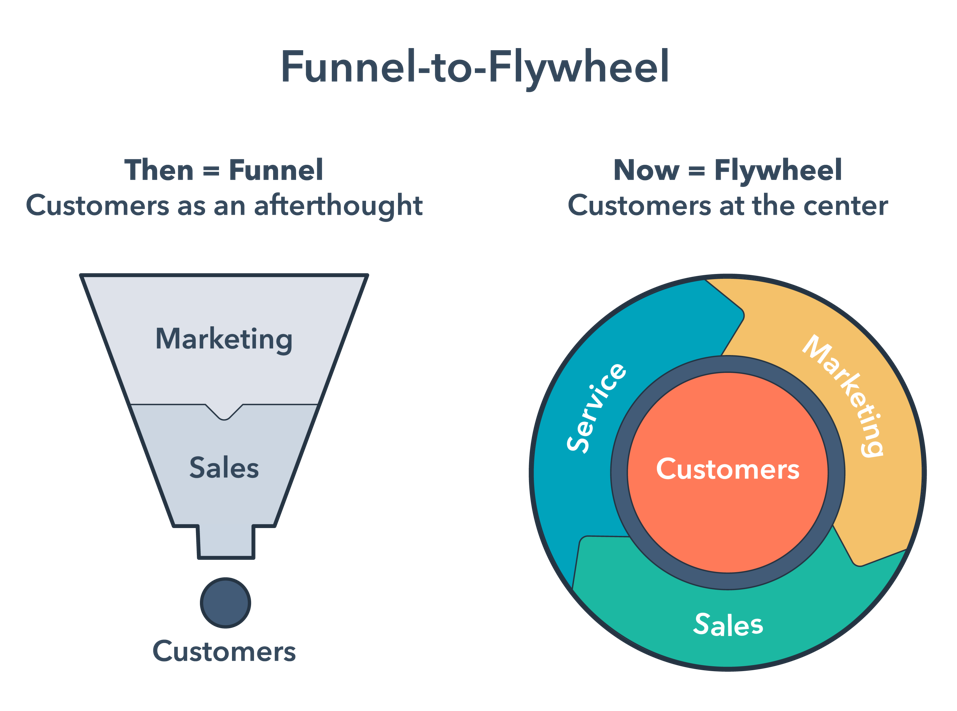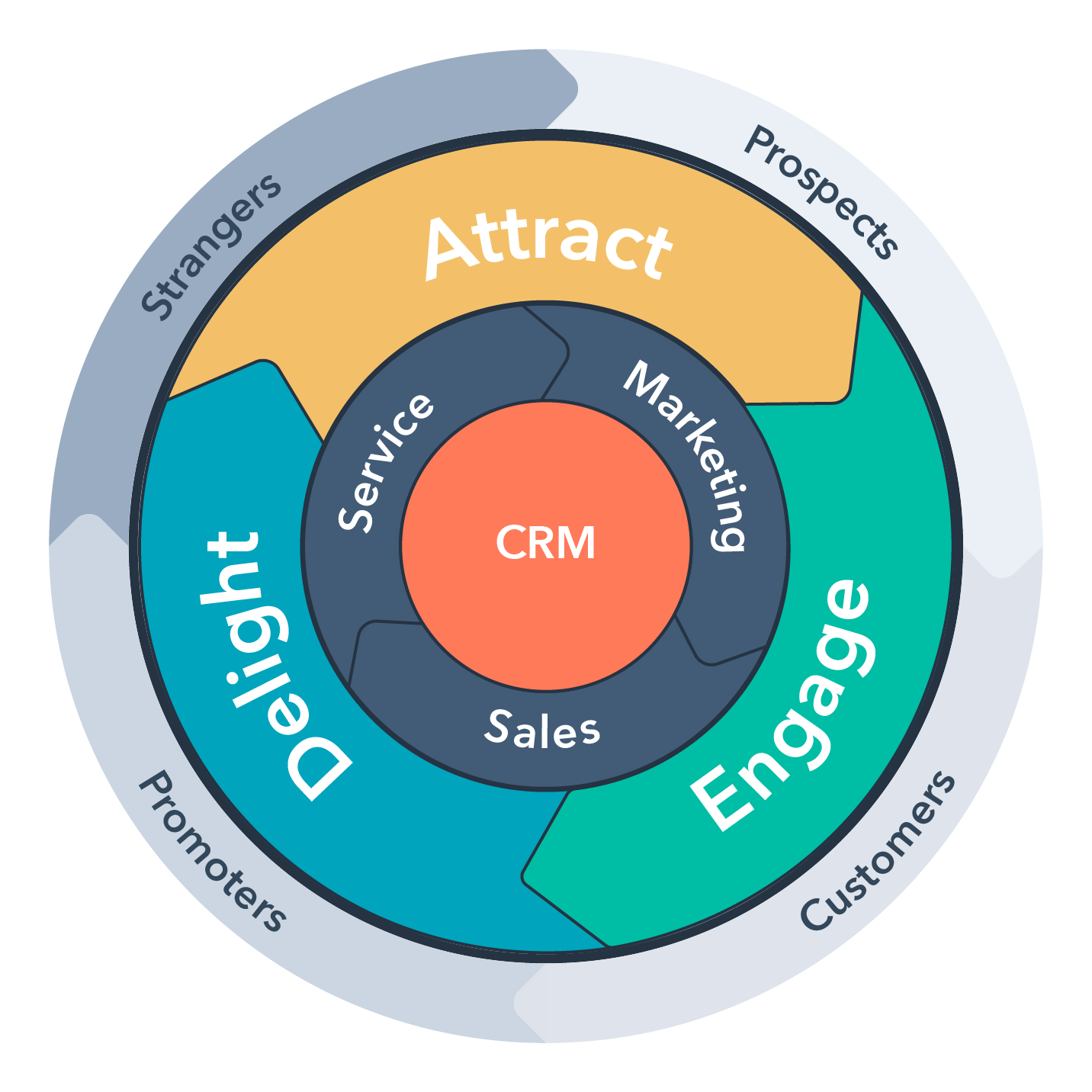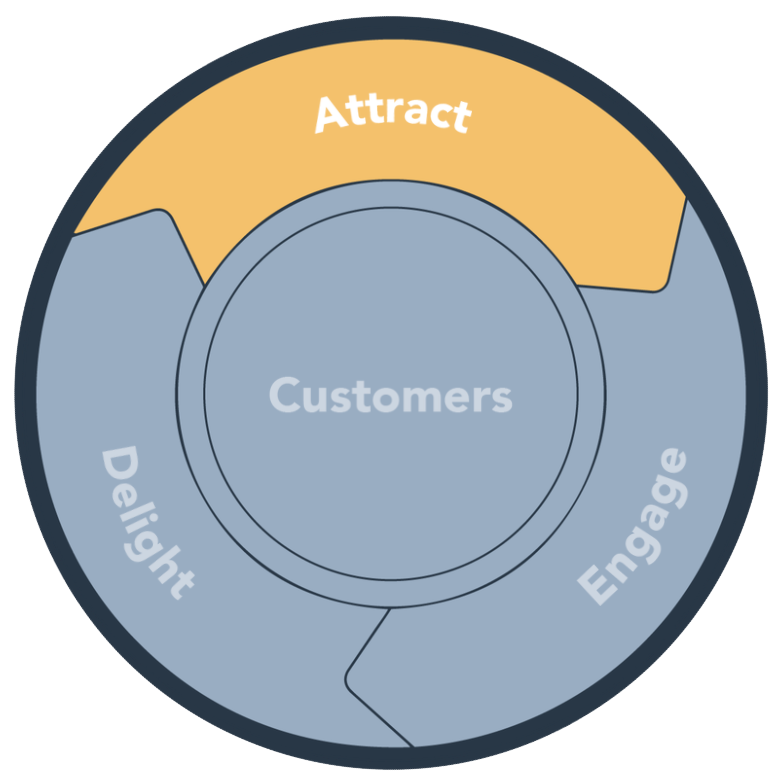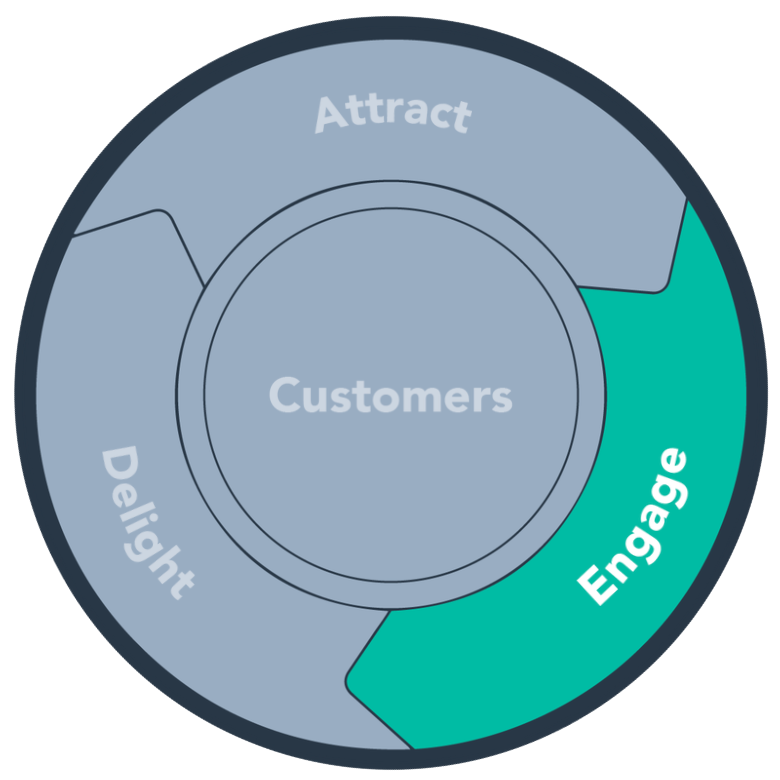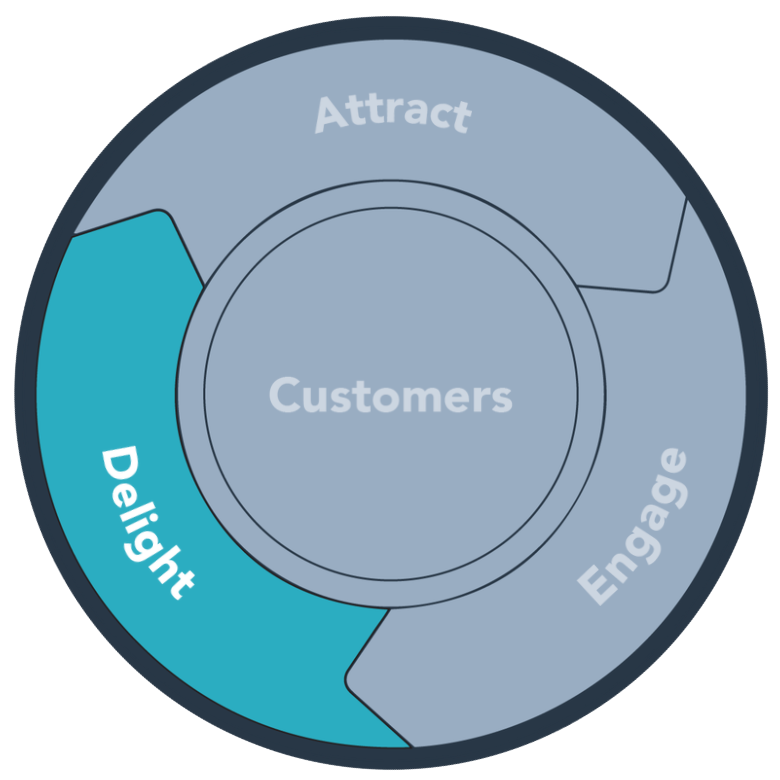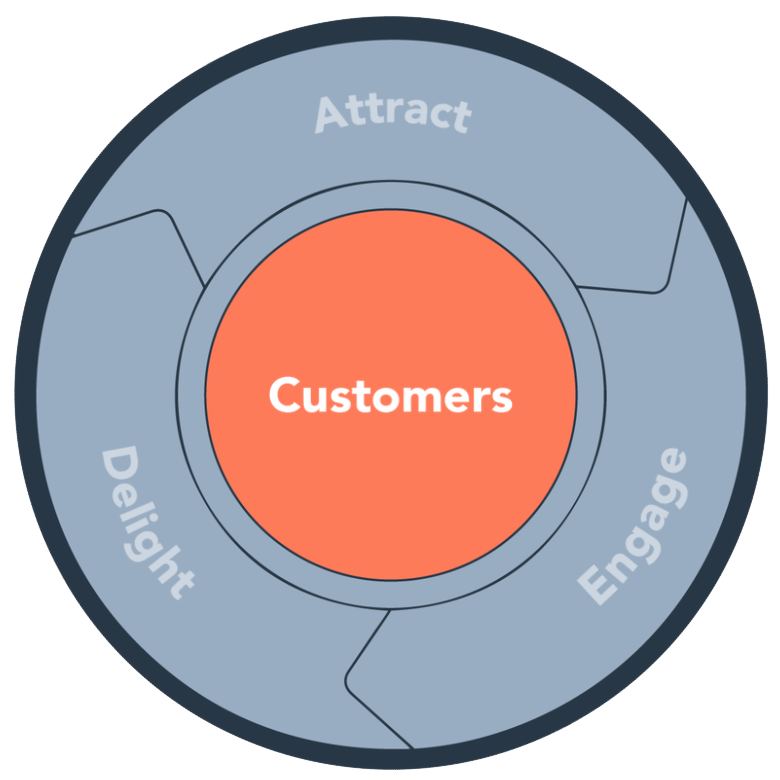Top HubSpot Flywheel Strategies
Back in 2018, we all said “So long funnel! Hello Flywheel!”. All thanks to Hubspot founder, Brian Halligan, marketing professionals united to overthrow a long-time way of thinking that was no longer working to our advantage. How? With the HubSpot Flywheel.
The Flywheel brought to light one of the major problems with the marketing funnel. That is – the prioritization of and over-investment in marketing and sales caused us to overlook the importance of caring for our customer base. The funnel ideology moved customers through the sales process, only to drop them like hot potatoes in the end once they’ve completed their purchase. From the attract stage to after the sale, we must engage our customers to create return customers.
As marketing experts and agencies around the world have heeded HubSpot’s advice and introduced the Flywheel into their inbound marketing strategies, we’ve come to realize its true value in accelerating growth. From our marketing approach to our sales techniques and customer support, HubSpot flywheel strategies turned our focus to the most important phase of the inbound methodology – to attract, engage, and delight the customer with a stellar customer experience.
Funnel VS Flywheel
Besides its obvious shape, what is the distinction between the funnel and the inbound marketing flywheel? What key differences are responsible for improving our inbound marketing approach? Finally, how does the Flywheel model help grow your business?
The Marketing Funnel
The marketing funnel is linear. It works to attract prospects to the top and move them through the sales process. Once they’ve made their decision to purchase, they follow throughout the bottom of the funnel and out of our minds. From the attract stage to the sale, we MUST follow-up with target customers to provide a comprehensive customer experience.
One of the first problems with this is that it treats all leads the same. It assumes that all potential customers enter the sales process (or top of the funnel) at the same stage of their buyer’s journey – when this isn’t the case at all, especially in today’s world.
In 2020, buyers can do their own research about a product. With Facebook, Instagram, Yelp, Google, blog posts, and word of mouth, etc., prospects are able to learn about a product or service long before they even visit your website or interact with your sales team. Potential customers essentially walk themselves through your funnel.
Furthermore, the outdated funnel is based on the idea that once a customer buys your product, they are no longer involved with your company. All of the time it took to generate that lead, engage with them, and nurture them into a sale is a waste and you’re all the way back to the start. The next quarter, month, or week rolls around and back to the top of the funnel your team goes.
The funnel ignores one of the most important aspects of the buyer’s experience of today: the customer’s ability to be an active promoter of your brand and attract more business.
The Flywheel
The flywheel on the other hand takes into account that a customer can enter their journey at any phase of the sales cycle. Some might already be able to purchase. Others may know a little bit about your business and products. And still, there will be some leads that have never heard of your brand.
It places your customers in the center and, just like any other wheel, spins in a circle continuously moving your customers through each phase of your inbound marketing strategy. As your flywheel picks up speed, it builds momentum and moves your business forward.
And what pushes the wheel? The delight and satisfaction of your customers. Satisfied customers become active promoters of your brand, which drives more sales and generates more satisfied customers to do the pushing. As your flywheel spins faster, the growth of your business accelerates more and more.
HubSpot Flywheel with Inbound Marketing
HubSpot flywheel strategies go hand in hand with your inbound marketing strategy. It helps every department of your company work more effectively and efficiently. The flywheel structure encourages each team to focus on delighting the customer so that it can continue to spin.
Marketing Flywheel
Marketing teams can greatly benefit from a flywheel framework. They can more powerfully attract qualified leads, and establish the foundation of a loyal relationship right from the get-go.
Attract
The attract phase of your inbound marketing efforts for your marketing flywheel involves tactics such as social media outreach, content creation, search engine optimization (SEO), and paid advertising that works to drive ideal customers to your website. These customers are the ones that will benefit most from the solutions you have to offer.
The following is a list of the HubSpot flywheel strategies for your inbound marketing campaign:
- Informative blog posts and how-to guides
- Social media presence
- SEO keywords
- Content offers
- Customer Testimonials
The essential aspect of this stage is meeting your potential customers where they are at. This involves developing your target buyer personas and understanding their unique challenges, needs, and motivations. A clear understanding of your buyer personas will give you a comprehensive insight into what your customers are looking for and where they go to find it.
Engage
Marketing content sparks interest and lures visitors to your website. Now comes the time to properly engage with them in order to convert them into qualified leads and move them along in their buyer’s journey. The engagement phase includes using tactics such as pop-up forms, email marketing, chatbots, and marketing automation.
The following is a list of engagement tools for your marketing flywheel:
- Forms
- Landing pages
- Calls-to-action
- Emailing
- Virtual assistants and chatbots
At this point, you have the attention of a potential customer and must handle it with care. Rather than overloading the prospect with every piece of content that your marketing team has created, you’ll want to carefully nurture them with contextually-relevant communications that relate to what you know interests them.
Delight
A key factor about the delight phase is that it really isn’t a phase. It’s the driving force of your marketing flywheel and feeds into the attract and engage phases.
Delighting the customer involves the use of smart content, email marketing, conversational marketing, video, and long-form content that speaks to their needs. You want to deploy the most relevant educational materials that will help them see the value in your products or services.
The following tactics are essential to the delight phase of your marketing flywheel:
- Surveys
- Smart content
- Social monitoring
The idea is to create long-lasting brand loyalty by providing your customers with helpful content and an enjoyable experience that they will want to share with their friends, family, and others in general.
Sales Flywheel
The members of the sales team have been considered VIPs for ages. They are the ones that close the deals and bring in the money. The inbound flywheel strategy provides them with more ways to sell effectively and build stronger relationships with clients or customers.
Attract
Marketing and sales overlap in the attract phase of the flywheel. As your marketing experts engage and delight a lead with marketing content, your sales reps start to reach out to further the conversation and guide them towards the beginning stages of their sales process. Once the lead has shown sufficient interest in your products or services and offers up information to display that they would benefit from it, the sales process commences.
In other instances, prospects can be attracted directly into the sales flywheel. This is done through prospecting. A lead is drawn to the sales process by a personal connection that they made with a sales rep either on social media, in person, or through another form of communication-based on your companies value proposition and culture code.
A lead can be directly attracted into the sales flywheel through the following tactics:
- Prospecting
- Email sequencing
- Links to calendar
- Sales automation
Engage
During the engage phase, the conversation with sales begins and your sales team continues to effectively interact with them through meetings, calls, and emails. The mantra “always be helping” is the key to engagement for your sales professionals. It’s important to allow your prospects to decide both the channels and timeline of your communications, while sales focus more on their needs than selling as often as possible.
The sales flywheel during the engagement phase will involve the following:
- Phone conversations
- Emails and follow-ups
- In-person meetings
- Product demonstrations
- Case Studies and other sales content
Delight
Again, your sales reps should be focused on delighting their prospects throughout their sales process to continue pushing the flywheel faster and faster. To do so, it’s imperative that your sales team makes it as easy as possible for prospects to buy from you. The bottom line is that you want to create the best buying experience possible.
Sales enablement materials can set your representatives up for success. Sales-ready content such as one-sheets, videos, and case studies can help to empower your potential customers with the information they need to make a final decision. For B2B customers, the right content will make it simple for them to share the value of your products with other decision-makers.
The flywheel encourages your sales team to go above and beyond to curate a delightful sales experience for your customers that they want to share with others, which turns into more business and more momentum to accelerate your growth.
Customer Service Flywheel
It goes without saying that the customer-centric structure of the flywheel would resonate with the customer service department.
67% of customer churn is preventable if the issue is resolved during the first interaction.
It is their core responsibility to ensure the satisfaction of their customers. The flywheel aligns the goals of your marketing and sales teams with customer service to provide the best sales experience.
Attract
Marketing and sales put in the effort to make the initial connection with a potential customer and attract them to the business. They do this with the goal of making the process of becoming a customer as seamless as possible, while also clearly showing the value of your product or service.
A useful way to achieve this is by bringing members of your service team onto sales calls, performing assessments, and providing product demos, and freemium offerings. You can give your prospects the opportunity to see first-hand how your products or services will benefit them by starting them out with a taste of what you have to offer.
Engage
Engaging with the customer for your service department involves delivering amazing customer service. It’s important that you establish straightforward expectations for communication and how customers can gain value from your offerings upfront. Then, the goal is to exceed those expectations and offer strong support for your customers as they learn the value of your offering for themselves.
Additionally, you should make self-service resources and knowledge bases available. These will help your customers maximize the value they receive from your products or services.
Delight
The most important factor in delighting the stage in regards to the service flywheel is expectation setting. This is a learned skill that all customer service reps should have. When you set realistic expectations for a customer from the beginning, you can then go above and beyond to exceed those expectations.
75% of consumers would engage more with loyalty programs that make rewards mobile-friendly.
When you help your customers see success with your product or service, they are most likely to come back to return the favor for you. These customers are the ones that will be most helpful when it comes to obtaining case studies, reviews, and referrals to help your company attract more leads.
But keep in mind – not all customers are destined to become evangelists for your brand, even if they were successful with your products or services. And there’s no problem with that. Just don’t invest too many resources into delighting a customer that is unappeasable and leave your other customers hanging.
Flywheel Methodology
While the marketing funnel thinks of customers as an outcome or a means to an end, the flywheel methodology focuses on the bigger picture and puts customers in the center of the sales process. They become active contributors to the growth of a business. That’s why it is important to invest in improving the buyer’s experience.
If you’re still stuck in the old funnel mentality, it’s time to adopt the HubSpot flywheel and watch your business grow exponentially. But how can you adjust your inbound marketing strategies to focus more on the customer and enhance their experience?
On The Customer’s Terms
The former structure of the sales process included full service and involved much more human interaction during a 9 to 5 setting. What has become more normal and expected today is self-service methods, round-the-clock access, and ways for customers to try a product before they make a monetary commitment.
HubSpot’s Halligan has said that instead of trying to improve your product to make it better than the competition, it’s smarter to focus on making your service better. And in order to do that, you’ll want to eliminate the friction of the process.
Modern day buyers don’t want to even leave their homes or interact with people as much anymore. They want to be able to shop from their couch and return the product if they aren’t satisfied with it. Ultimately, they want freedom with their buying experience.
Customers want to make decisions when they feel like it and on their own terms. This is an incredibly important thing to keep in mind and develop your strategy around.
Optimize for Mobile Use
These days everyone has a smartphone or portable device that they spend a substantial amount of time on throughout the day. This has become an incredibly popular way that customers become aware of a brand and enter into their early stages of interaction with it.
It is crucial to your business that you optimize for mobile use and take advantage of the opportunities available for you to attract and engage potential customers. Social media, premium mobile apps, and having a mobile-friendly version of your website are all essential.
Virtual Assistance
Another benefit of the technology is the ability to use chatbots and virtual assistants to help your customers find the information they need to help them make a purchase at any time of day. This is especially useful when you have a heavy influx of customers and not enough representatives to tend to all of them. A virtual assistant or chatbot can answer the questions that a customer might have and tide them over until they can speak with a real person on your team.
HubSpot Flywheel Take-Aways
The HubSpot flywheel model didn’t necessarily replace the marketing funnel completely. It took the effective aspects of the funnel and gave them the jumpstart they needed to evolve with the marketing landscape of today. HubSpot flywheel strategies can do the same for your inbound marketing campaign as well.
The marketing flywheel will work to attract, engage and nurture leads into active promoters of your brand by delighting them every step of the way. And once the momentum starts to build, your flywheel will start to take you places.

